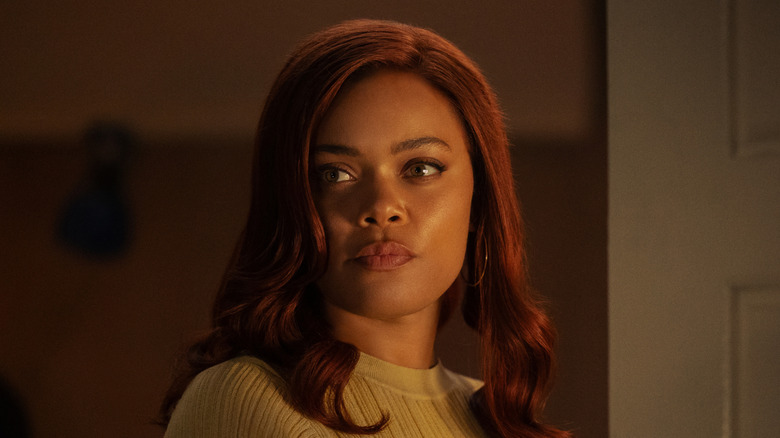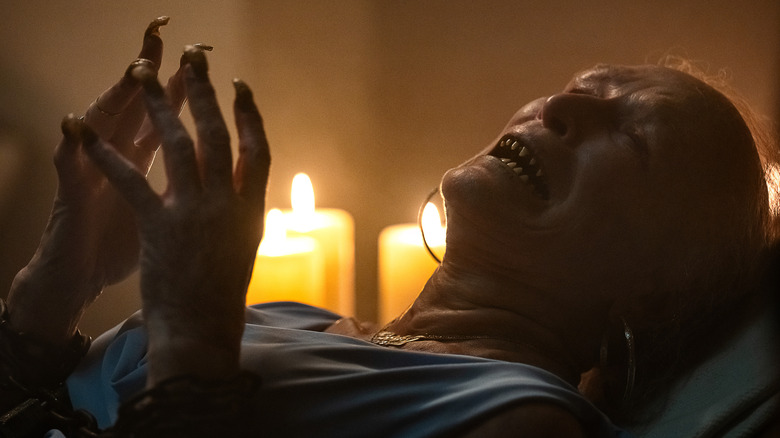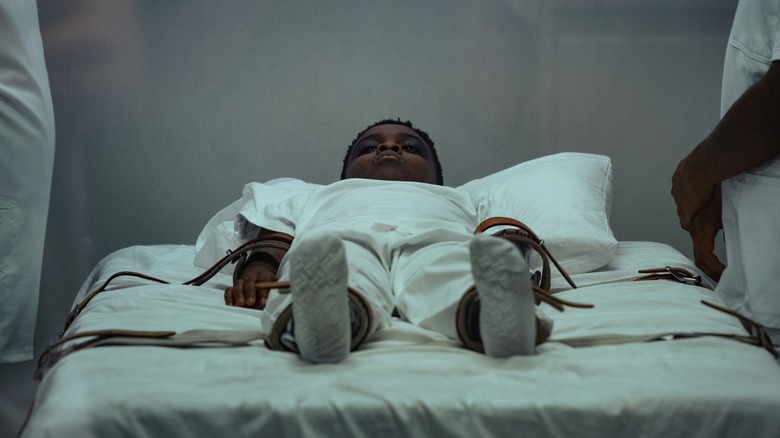The Terrifying True Story Behind Netflix's The Deliverance, Explained
The 2024 Netflix horror movie "The Deliverance" has intrigue written all over it. Not only is the movie directed and produced by Lee Daniels ("Precious," "The Butler"), but its story draws inspiration from an infamous real-life haunting case.
In the movie, the Jackson family's already turbulent life is thrown into supernatural disarray when they move into a new house and the youngest child, Dre (Anthony B. Jenkins), starts behaving strangely and talking about an invisible entity he calls "Tre." The family's single mother Ebony (Golden Globe winner Andra Day, "The United States vs. Billie Holiday") is already under threat of losing her children's custody thanks to a host of serious personal issues she doesn't always manage to keep to herself, and the authorities initially blame the Tre spirit's increasinly hostile behavior on her negative influence on her offspring. As things become increasingly volatile, Ebony and her children find themselves facing an insurmountable threat by themselves.
As per /Film's review of "The Deliverance," the movie is not what you'd call a critical darling, or even one of the scariest horror films of 2024. Still, "The Deliverance" isn't afraid to take big swings, which helped the demonic possession movie shoot straight to the top of the Netflix charts. It mixes supernatural scares with the all-too-real problems of a struggling single-parent family effectively, and even features eight-time Academy Award nominee Glenn Close as Alberta, Ebony's cancer patient mother — a role that Close found genuinely challenging even without the frankly wild scene where the possessed Alberta spits profanity, "The Exorcist"-style. Oh, and whether you're familiar with the film or not, the terrifying true story behind "The Deliverance" is very much worth knowing. Let's find out a bit more about the case the movie is based on, known as the Ammons haunting.
The Ammons haunting is a notorious paranormal case
The real-life Ammons Haunting started in late 2011 but gained attention after the Indianapolis Star covered it in 2014. When LaToya Ammons' family moved to a new house in Gary, Indiana, they started witnessing oddities. From strange swarms of flies to unexplained footsteps and more, the new house made its peculiarities known ... and soon enough, the family's 12-year-old daughter was found levitating above her bed.
LaToya and her mother, Rosa Campbell, started reaching out to religious organizations and spiritual operators, getting rejected by most and following whatever anti-demonic advice the remaining ones gave. Unfortunately, the bag of warding tricks they acquired failed to stop the problem, as the alleged evil spirits started possessing the family's children and wreaking an increasing amount of havoc. The possessions reached full-on horror movie levels with deep growly voices, wall-crawling, and supernatural strength, and even some professionals like doctors and police captains ended up convinced of their authenticity. Others deemed it all an act, prompting an investigation by the Department of Child Services.
The authorities ended up collecting hundreds of pages of material on the case, and numerous people witnessed the children's allegedly supernatural behavior during their equally alleged possessions. The DCS ultimately took the Ammons children in custody after determining that they'd been adversely influenced by their mother, but people (including police officers and a representative of the Catholic church) continued to experience an array of supposed paranormal phenomena in the house even without the kids being present. After multiple dramatic exorcisms and a DCS-approved reunion of the family in early 2013, the haunting seemed to be a thing of the past, leaving behind factions of skeptics, believers, and curious onlookers alike.
The key differences between the Ammons Haunting and Netflix's The Deliverance
Both "The Deliverance" and the Ammons haunting case feature a family with a single mother, a grandmother, and multiple children. Both families move to a new house and encounter otherworldly forces that target the children in particular. Both stories are rife with religious themes and feature a confrontation with the DCS, which is understandably skeptical of the supernatural narrative and seeks to protect the kids from their mother's influence. Both end with the family back together and the forces of evil swept aside. Because of the "inspired by" nature of the movie, such similarities are understandable, even though Lee Daniels told The Hollywood Reporter that he was wary of interacting with LaToya Ammons herself:
"I purposely didn't want to meet her because I was nervous. But I spoke to her, I believe once or twice, in the beginning. And she's lovely. She was at peace."
That being said, there are differences. Apart from names, locales, and the particular nature of the hauntings and their aftermath, there's also the matter of the real-life case's authenticity. "The Deliverance" understandably plays the supernatural haunting elements of the story straight, giving the Jacksons a very real paranormal threat to unite against. The Ammons haunting is somewhat murkier. The family doctor, Geoffrey Onyeukwu, admitted to being weirded out by what he witnessed, but labeled it as the family's delusions and hallucinations. After the story went public, skeptics have picked it apart, pointing out many discrepancies between the haunting narrative and the actual events. All in all, if you have to choose between the Ammons case and "The Deliverance" for your horror fix, let's just say that the latter may offer more reliable thrills.
"The Deliverance" is available for streaming on Netflix.


